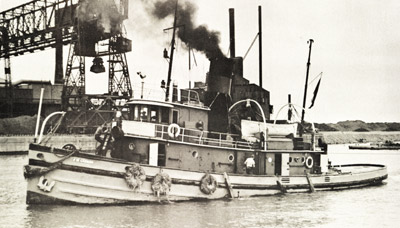Table of Contents
We are all, no doubt, familiar with the sight of retired vessels lying at dock or at anchor in the various lake ports awaiting sale to other operators or scrappers. Such ships may begin to look a trifle rough after a couple of years of inactivity as the sun bleaches and bubbles hull paint and soot in the air leads to smudges on whitework. However, at no time has your Editor seen anything to resemble what may be seen at the presesnt time in the Strathearne Street slip in Hamilton Harbour.
Earlier in the year, we reported that the last remaining steam tugs of the Canadian Dredge and Dock Company Ltd. had been towed to Hamilton where all three were to be broken up. The trio was not scrapped at C.D. & D's own pier as were other superannuated steam tugs, but are currently being cut up by United Steel and Metals.
All that is left of FRANK DIXON, built in 1920 at Dartmouth, England, is her grimy gray hull, completely stripped of cabins and machinery. In fact, the day we saw her, the hull of the DIXON was swinging out into the slip, her forward mooring lines having chafed in the rusty fairlead until they parted. STRATHMORE, built in 1911 at Midland and the oldest of the group, was partially cut down. All the fixtures had been stripped from her cabins and her pilothouse had been cut away, leaving only her very tall funnel protruding above the boat deck.
By far the saddest sight of all, however, is what remains of A. M. GERMAN. Built in 1926 at Midland, this tug was, in your Editor's opinion, one of the most handsome steel tugs ever seen in these parts. Now, however, she lies devoid of any navigational equipment. Her paint is faded and blistered and her forward cabin shows evidence of severe damage by fire some time in the past. Burned areas are well rusted over and every port and window in the vessel has been smashed. Woodwork in the pilothouse hangs in strips and the frames of several unshuttered windows have been wrecked beyond repair. The funnel is so badly rusted that daylight can be seen right through it in several spots. Never have we seen a ship in such sickening condition.

During happier days, the Canadian Dredge & Dock tug A. M. GERMAN is seen at work in Port Colborne Harbour, May 10, 1958. J. H. Bascom photo.
The three tugs last operated about 1958 in the preparations for the opening of the St. Lawrence Seaway. In the intervening years, we held hopes that they and their already-scrapped mates such as MINNICOG and SHAWANAGA might be converted to diesel power as were G. W. ROGERS and TRAVELLER, but this was not to be. If these faithful workhorses cannot be rebuilt and put to use by other owners, then we sincerely hope that the scrappers may do their job quickly and put all three out of their misery as soon as possible.
Previous Next
Return to Home Port or Toronto Marine Historical Society's Scanner
Reproduced for the Web with the permission of the Toronto Marine Historical Society.